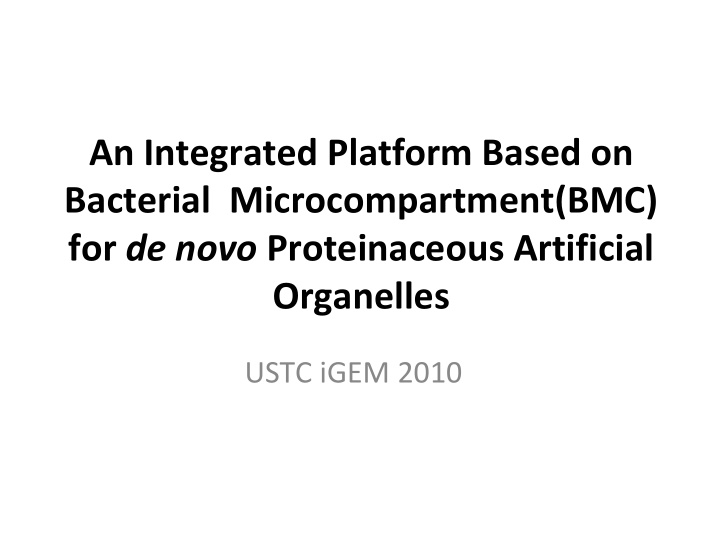



An Integrated Platform Based on Bacterial Microcompartment(BMC) for de novo Proteinaceous Artificial Organelles USTC iGEM 2010
About our ideas Problems in chemical production • Bacteria will be harder to stand this circumstance with the concentration of the chemical products. • The host cell’s matabolic pathway may interfere the inducted reactions. • Difficult to enrich those products.
About our ideas * Artificial Organelle in Procaryote Host-Cell-Free Reaction Chamber * From MOLECULSR EXPRESSIONS TM
Brief introduction of our presentation Background Introduction BMC Assembly Procedure BBF RFC 53 Modeling Conclusion & Future Tasks
What is BMC? • Polyhedron-Shaped • 80 to 200 nm • Comprising of several Thousands protein * and enzyme submits * Todd O. Yeates,Bacterial Microcompartment Organelles: Protein Shell Structure and Evolution, Annu. Rev. Biophys. 2010. 39:185–205
What for? • Ecapsulate many sequentially acting enzymes. • Enhance the efficiency or protect * the cell from toxic intermediates . * Todd O. Yeates,Bacterial Microcompartment Organelles: Protein Shell Structure and Evolution, Annu. Rev. Biophys. 2010. 39:185–205
BMC Diversity • Provide diverse metabolic functions. • Share an evolutionary related shell, which is defined by a related * protein domain. * Todd O. Yeates,Bacterial Microcompartment Organelles: Protein Shell Structure and Evolution, Annu. Rev. Biophys. 2010. 39:185–205
The Pdu Microcompartment • Fully understood • Complicated in structure, with high potential in future uses • Not strictly regular in * structure * Joshua B. Parsons, Synthesis of Empty Bacterial Microcompartments, Directed Organelle Protein Incorporation, and Evidence of Filament-Associated Organelle Movement , DOI 10.1016/j.molcel.2010.04.008
Genes and Protein Fusion A B J K N T U * * Joshua B. Parsons, Synthesis of Empty Bacterial Microcompartments, Directed Organelle Protein Incorporation, and Evidence of Filament-Associated Organelle Movement , DOI 10.1016/j.molcel.2010.04.008
Our Goal • Construction of the BMC shell in vivo . • Encapsulation our target enzymes into our microcompartment.
Procedure Genomic DNA from Citrobactor.freundii. Altogether over 15 primers & 14 BioBricks.
Tests Result Figure. SDS-PAGE of composite BBa_K371019
TEM Result 150nm +1.0 mM IPTG/16 ° C -IPTG
The motivation to design BBF RFC 53 Existing Standards: Shortcomings: • Frameshifted Scar Standard scar TAC TAG AG RFC 10 • Limited linkers (frameshifted) • Incompatibility RFC 25 ACC TCC (Thr-Gly) with RFC 10 … RFC 37 Thr-Arg, Ser-Gly, etc. … …
An Introduction to BBF RFC 53 The prefix and suffix of BBF RFC 53
An Introduction to BBF RFC 53 Meta- Meta- Prefix Suffix
Construct BioBrick parts in RFC 53 • Long parts -- PCR • Short parts : RBS, linker, tag, ect. -- de novo DNA synthesis Oligo 1 Oligo 2
Assembly in RFC 53 What’s D - part & L - part D - part L - part
Assembly in RFC 53 Concept : D - part & L - part D - part L - part D - part
RFC 53 assembly and fusion • five fusion methods:MetaFusion, HeadFusion, TailFusion, HXTFusion, and FullFusion. • http://bbf.openwetware.org/RFC.html
Vector Insert B A SapI PF MSF SF PF MPF MSF SF MPF SacI AGCTCTTCA ATG AGGAGCT CTTC TCGAGAAGTTAC TCC TCGAGAAC PF SF MPF MSF MPF PF MSF SF SacI EarI GGTTGAAGAGAT AGGAGCT CTTC CCA ACTTCTCTA TCC TCGAGAAC PF SF MPF MPF MSF PF MSF SF A*B SF MSF PF MPF PF MSF SF MPF
Verifiation RFC 53 • P 1-64 fuse with GFP Confocal microscope result
Assembly BMC BioBrick under RFC 53 standard
Highlights of RFC 53 • Compatible with RFC 10 standard; • Support protein fusion; • The assembly scar is at most 3 bp • Assembly strategy is ranther flexible; • Enzymes used is not too expensive ; • Can be used as a de novo DNA synthesis method and a site-directed mutagenesis method; • ...
Modeling Goal: To evaluate the probability for pdu microcompartment to be used as a reaction chamber for different uses 1.modeling 2.co-evolution analysis Hypothesis: PduN is the vertex. Hexamers form the facets Icosahedral with a regular hexagon of same size
Step 1: Modeling Volume: ~32000 nm 3 About 1/1500 of a single bacterium Rubisco: ~10 3 nm 3
Step 2: Co-evolution analysis N-terminal sequence of inside components PduO PduL PduG PduP PduC PduH PduQ PduE PduD shell components PduK PduA PduN PduB PduU PduJ PduT
Future--- Fusion Protein Our microcompartment: Improved Efficiency + Reaction chain + Toxicity reduction Reac acti tion Ch n Cham amber Pollution Treatment inside surface outside surface Drug delivery
Future--- BMC as a unit in novel construction • Material • Molecular selection
Summary • Succeed in constructing functional in vivo pdu microcompartment constructed in BBF RFC 10. • Establish an efficient and highly compatible novel standard for fusion proteins. • Manage in finding bioinformatic evidence of pdu microcompartment as a reaction chamber with diverse application potentials.
Acknowledgement • Instructors • Advisors • Sponsor USTC Initiative Foundation Prof. Haiyan Liu Hao Jiang Graduate School, USTC Prof. Jiarui Wu Alumni Foundation, USTC Zhaofeng Luo School of Life Science, Physics, Computer Science, Jiong Hong Math, USTC Our Team
Supplementary • Figure 1| Flow chart of the process of co-evolution computational of pdu microcompartment.
Recommend
More recommend